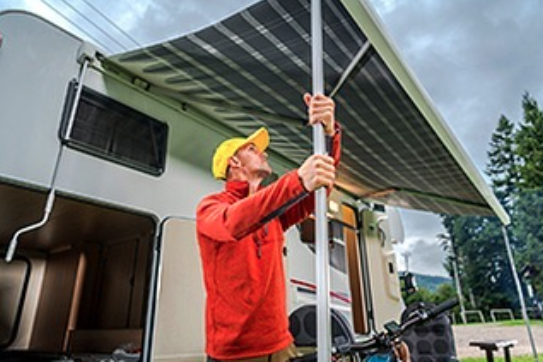Sarasota Insurance Agency >> blog

When one pictures an RV’s exterior, this mental image usually includes a big awning unfurled right by the front door. While the awning may not receive as much thought as the interior or mechanical components of an RV, it is still a rather essential piece of the overall RV experience.
The awning has many uses. It provides shade in the heat of summer and protection from rain and other elements year round. For many RVers, it also serves to extend the total living space to the outdoors, creating a front porch area of sorts. This front porch area then often becomes a comfortable place to work, eat, or relax. In addition, an awning can provide protection to one’s outdoor belongings, such as bikes, kayaks, chairs, and more.
Although it is utilized often and has many functions, the awning is often overlooked for routine maintenance. However, RV awning maintenance is an important part of RV ownership and should be performed regularly. Follow these basic tips to keep your awning in tip-top shape.
Dirt stains, sap and leaves from trees can leave your awning looking dingy and worn. Mold and mildew can also build up quickly, and all of these factors combined can cause unpleasant odors and unsightliness. Routine washing will help to minimize these occurrences. Most of the time, a light spray with a hose is sufficient to clean dirt and debris off your awning. However, if stains persist, you can use a soft, long-handled brush and some mild soap to scrub them out before rinsing. Be as gentle as possible to avoid removing the protective waterproof coating.
Depending on your volume of usage, regular cleanings may be required more or less frequently. If you are a full-time RVer, you will want to clean your awning at least three or four times per year. If you are a part-time RV vacationer, a thorough cleaning once or twice a year should suffice. No matter how often you use your RV awning, be sure to clean it with a proper awning cleaner at least once a year. These can be found at most RV supply stores and should be sprayed onto the awning before scrubbing or rinsing. Follow all package instructions for best results.
Improper drying practices can be extremely damaging to your awning. These can cause mold and mildew growth, as well as fabric dry rot and rust on your awning’s mechanical components. If you have recently cleaned your awning, be sure to allow if to fully dry before you roll it up and store it. In addition, if your awning was left open on a rainy or humid day, it should be allowed to dry for at least three additional days before putting it away. This is especially important for those who use their awning less frequently, as it can stay damp on the inside for weeks after you roll it up. Ensure that your awning is completely dry to prevent unnecessary issues.
Most awnings have a locking mechanism that many RVers overlook. Locking your awning in place will prevent it from opening and ripping off during travel at high speeds. To avoid damage in transit, be sure to utilize the safety locking device when storing your awning for travel.
Although the awning’s main purpose is to provide shade from the sun, constant UV rays can, unfortunately, damage your awning over time. When you are not using your awning for shade or heat prevention, roll it up and stow it away to minimize damage from the sun’s strength. This is especially pertinent if you are a full-time RVer who utilizes their awning often or if you take lots of trips during the summer.
As mentioned above, stowing your awning away when the sun is especially strong helps to minimize sun damage. In addition, keeping it away during heavy rain and allowing it to fully dry before storing it is also important. When it is raining, position one side of the awning lower than the other to allow the rain to run off instead of pooling in the center. Heavy, pooled water can cause your awning to wear quicker than usual.
Heavy winds can also damage your awning. If the wind speeds are in excess of fifteen miles per hour or more, it is best to store your awning until the winds have calmed down. If you cannot put your awning away during a period of strong winds, keep a close eye on it. The strongest winds can rip it off entirely.
If you camp often in regions with high wind speeds, an RV awning stabilizer kit could be very valuable to you. This will help to keep your awning from flapping around in the wind, which can damage the fabric and the mechanical parts. This device may not be necessary for all RVers, so be sure to do your research before deciding if it’s right for you.
Despite proper maintenance and care, your RV’s awning will wear as it ages. In order to stay ahead of any potential issues, you should thoroughly inspect your awning at least twice per year. Follow this basic guide:
Awnings are a very useful tool to RVers and can provide extra comforts in your home away from home. There is nothing like enjoying a home-cooked meal outside at your campground or Harvest Hosts location, especially under the cool shade provided by your RV awning. Stick to these basic tips and tricks to ensure your awning stays in great condition and wears well through many enjoyable years of use.
Information from: harvesthosts.com2023-07-21 07:18:43